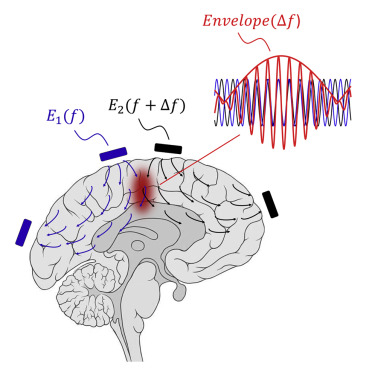University of Minnesota researchers show that “temporal interference” works to precisely stimulate deep brain regions without the need to implant an electrode

By Anne Hilker
Current demographic trends predict the population of elderly Americans will nearly double by mid-century. With the growth in this population, we can expect an increase in the incidence of neurological diseases such as Parkinson's and Alzheimer’s disease. Sometimes, symptoms of these diseases can be correlated to specific brain circuits that are not functioning as they should. Those circuits can be targeted by brain stimulation, or neuromodulation.
Neuromodulation therapies in development at the University of Minnesota have the potential to restore some function and manage these symptoms.
For example, deep brain stimulation (DBS) is type of neuromodulation therapy frequently used to treat movement disorders like Parkinson’s disease, and involves the surgical implantation of a small stimulating electrode into the brain. While DBS has been proven safe and effective, there are risks associated with any surgery. Precisely targeting deep brains structures using noninvasive modalities might one day enable the application of DBS as an alternative to surgical treatments available today. It may also advance new therapies for other brain diseases by allowing stimulation of brain regions not easily accessed by surgery.
Suhasa Kodandaramaiah, professor in Mechanical Engineering, is developing a novel, noninvasive approach to DBS, known as temporal interference, with funding from MnDRIVE. The technology has the potential to stimulate neurons deeper in the brain without affecting neurons in more superficial layers.
Imagine hitting a tuning fork. As the tines vibrate, they emit a pattern of high frequency sound waves. When two tuning forks vibrate at slightly different frequencies, they create a phenomenon called beating, where the two high frequencies combine to create a sound at a frequency equal to the difference between the two original frequencies.
Kodandaramaiah and his collaborator, Nir Grossman, professor in the Division of Brain Sciences at the Imperial College London, applied a similar principle using alternating electric fields to manipulate the neurons in the brain and regulate motor functions. The brain is not affected by high frequency electrical fields. In a study performed in Professor Ed Boyden’s laboratory at MIT, they succeeded in stimulating the brain with two high-frequency electric fields that created pulses capable of regulating the activity of neurons. "You have two high-frequency electric fields at slightly different frequencies interfering in the brain. At the spot where they intersect you can stimulate neurons. Everything else is unaffected," says Kodandaramaiah.
This novel approach to neuromodulation initially met with skepticism. “There were at least a dozen people who told us it wouldn't work,” Kodandaramaiah noted, “and there was a long period of really frustrating work which didn't lead to anything, but once it started working, it was an Aha! moment."
Though still in the experimental stages, the technique has shown promise in mice and offers hope for an effective, noninvasive therapy for people suffering from neurological and neuropsychiatric disorders.
For more information on temporal interference, see the research team’s publication in Cell.
Anne Hilker is a Strategic Communications major in the University of Minnesota’s College of Liberal Arts and a former intern in the BioTechnology Institute’s Science Communications Lab.